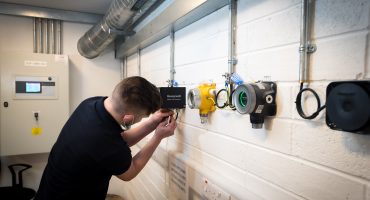H2S is the chemical formula for Hydrogen Sulphide. H2S is a highly dangerous gas that is flammable and harmful to humans. Smell is no indicator of the absence of gas, as many gases are odourless. Hydrogen sulphide has a rotten egg smell at low levels, but cannot be smelt at high concentration levels. In addition to this, H2S can cause you to lose your sense of smell without noticing, making it a highly dangerous situation for workers to find themselves in.
Any worker involved with crude oil, drilling, natural gas, petroleum, agitating slurry may be at risk of exposing themselves to hydrogen sulphide gas. In a lot of instances, confined spaces such as manholes, inside gas pipelines, containers etc can have high concentrations of gas, presenting a hazard. When carrying out checks in these confined spaces it’s important to check the top, middle and bottom of the area with your gas detector as different gases and concentrations may be present at levels. It’s important to remember that H2S is heavier than oxygen and natural air and so sinks in most scenarios.
The measurement of gas exposure is PPM ( Parts per million). The table below identifies the effects at different ppm levels.
Concentration (ppm) | Health Effect
Even at low level the gas can cause serious illness if exposed to it for a long period. For instance, exposure to 10 – 15ppm for 4+ hours is almost certain to cause conjunctivitis. A safe level of H2S is miniscule but any of H2S presence identifies a potentially bigger threat.
As highlighted previously H2S can be a highly poisonous gas with deadly consequences. As an odourless (at high levels) and colourless gas it’s difficult for humans to detect without assistance from an apparatus. Every worker should have their own personal gas monitor and in most cases not only will they detect hydrogen sulphide exposure but will also be able to detect a range of other gases. These detectors will be able to identify exposure limits and typically alarm levels start at 5 ppm.
There are also practical steps you can take such as ensuring proper ventilation, and removing hazards and materials that may cause a build-up of H2S. These steps, while important, do not replace the need for a gas detector.
A H2S alarm or gas detectors are required by law in some countries for the protection of employees in certain environments such as confined spaces or when working with sewage.
If you are concerned about your responsibility as an employer or would like to learn more about gas detectors or have any questions contact us for more information.
We recommend the H2S Clip as a single gas monitor but there is a range of gas detectors and devices that will ensure the safety of your employees and help you to reduce any danger
More links to dangerous gases and H2S:
From the Blog



If you have any questions about our products or services, please feel free to contact us.

Join our mailing list to receive the latest news and updates from our team.